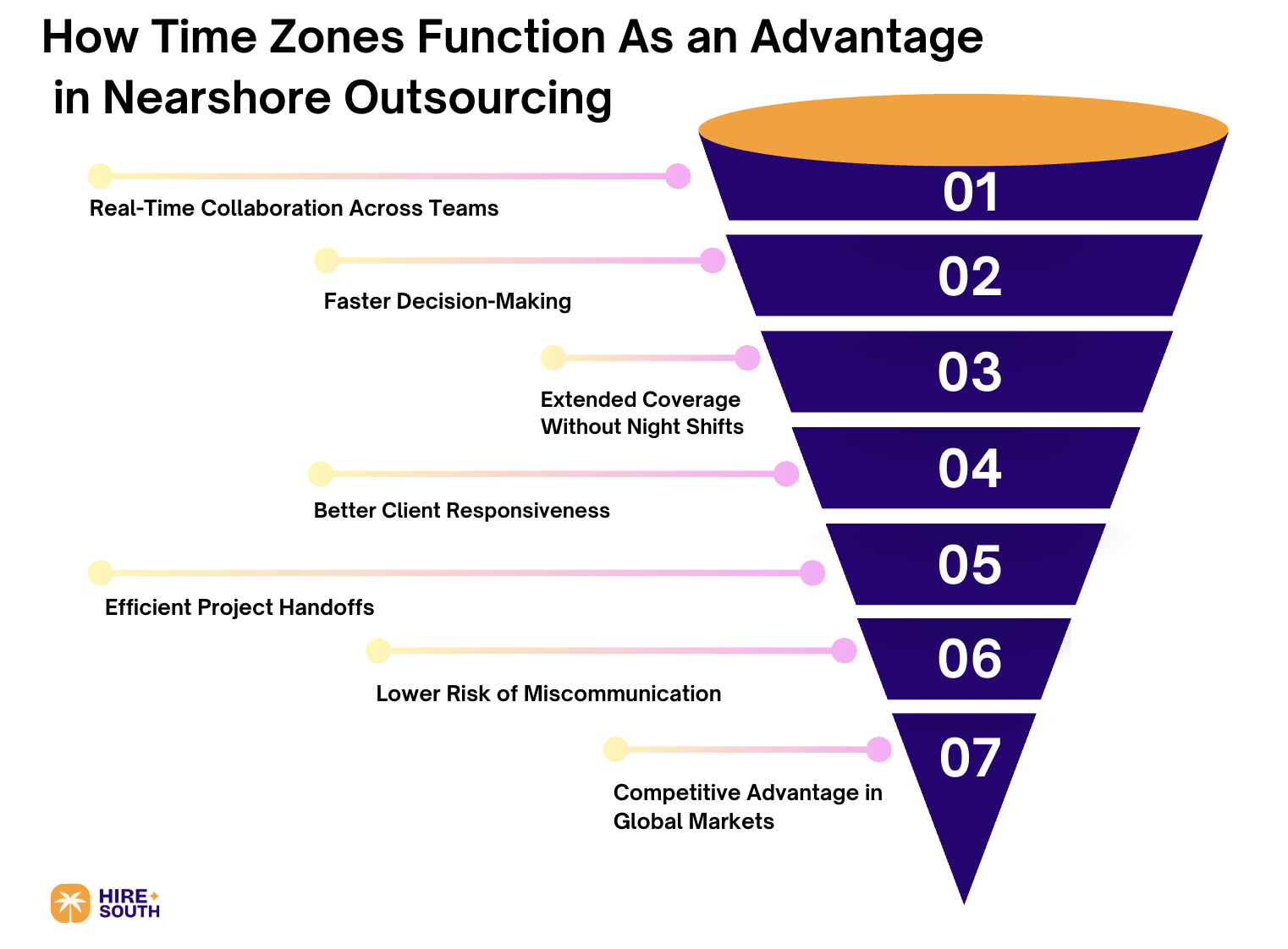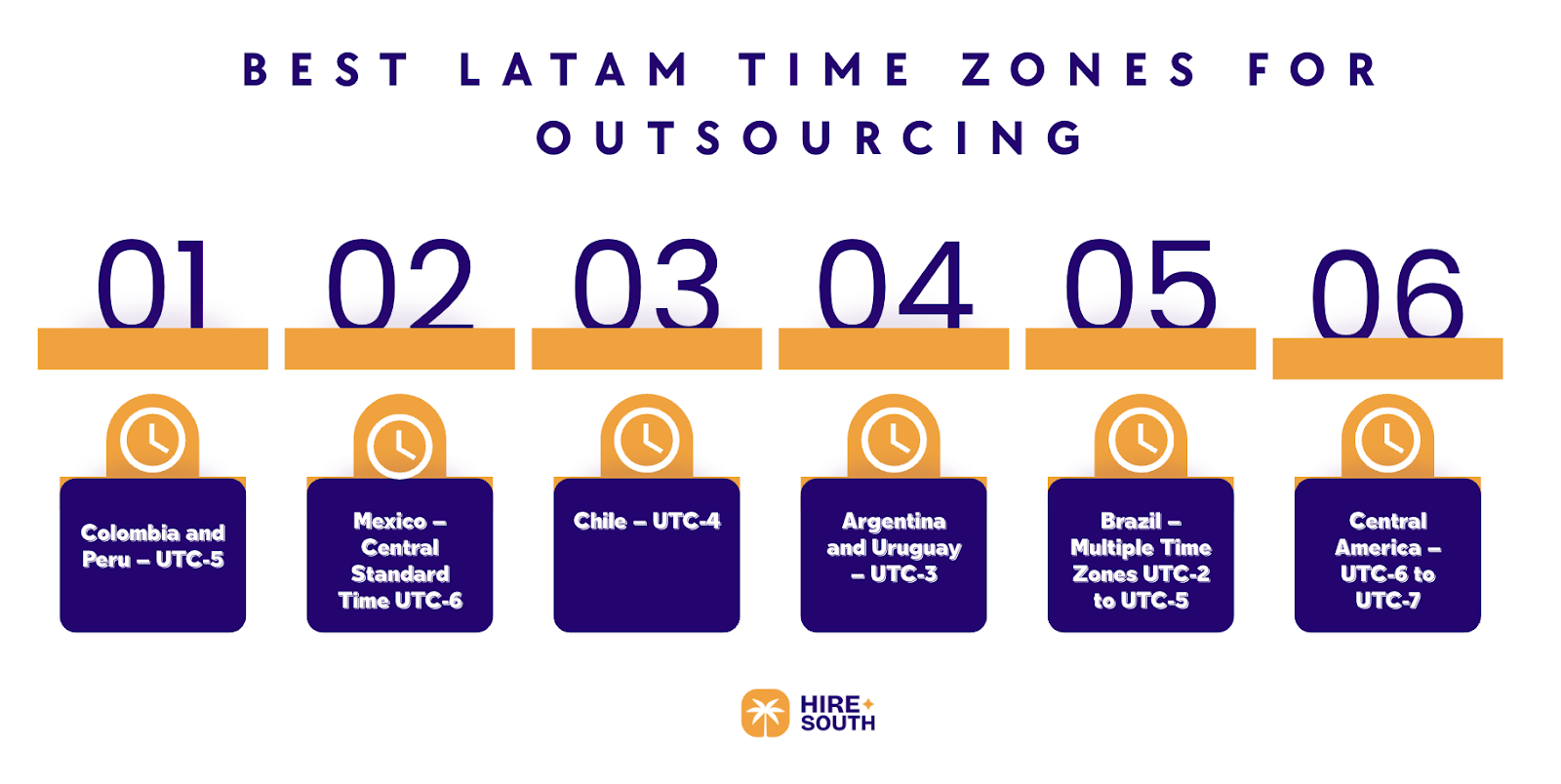Choosing the right outsourcing destination in Latin America isn’t just about talent or cost, with time zones playing a critical role in keeping communication smooth, projects on track, and teams aligned. For US companies, the overlap is especially appealing. More than 60% of Fortune 500 companies already outsource at least part of their operations, according to the Deloitte Global Outsourcing Survey, and many select LATAM precisely because its time zones sync with North American working hours.
This article breaks down the different Latin America time zones, explains why alignment matters, and highlights which regions offer the best fit for outsourcing. You’ll see comparisons with US and European business hours, industry-specific recommendations, and real-world case studies.
If you’re looking for clarity on where your business can gain the most from nearshore outsourcing, this guide covers everything you need. Keep reading to learn more!
How Time Zones Function As an Advantage in Nearshore Outsourcing

Real-Time Collaboration Across Teams.
When your teams share overlapping working hours, communication becomes seamless. You can schedule meetings, discuss urgent issues, and resolve blockers without waiting for the next day. LATAM countries like Colombia and Peru share nearly a full workday overlap with the US East Coast, which can increase project efficiency by up to 25% according to McKinsey’s Global IT Outsourcing Survey.
Faster Decision-Making.
Time zone alignment allows your business to act quickly. Approvals, code reviews, and client feedback happen within the same day, rather than being delayed by several hours or even overnight. Faster decision-making directly reduces project lead times and accelerates go-to-market timelines.
Extended Coverage Without Night Shifts.
Nearshore outsourcing in compatible LATAM time zones lets you provide extended business coverage without requiring night or early-morning shifts. This improves employee satisfaction and reduces burnout, while keeping operations active across more hours than a single office.
Better Client Responsiveness.
You can respond to customer inquiries and service tickets during the same hours your clients are working. Companies that maintain real-time responsiveness see a 20–30% increase in customer satisfaction scores, according to Zendesk’s Customer Experience Trends report.
Efficient Project Handoffs.
When teams are aligned by time zones, handoffs between departments or offices become smoother. Work-in-progress moves quickly from one team to the next without delays, improving throughput and reducing error rates.
Lower Risk of Miscommunication.
Time differences can lead to misunderstandings or delayed clarifications. Nearshore outsourcing in the same or adjacent time zones minimizes this risk, ensuring instructions, specifications, and feedback are interpreted correctly in real time.
Competitive Advantage in Global Markets.
Businesses that can operate synchronously across regions gain a market edge. Faster development cycles, quicker customer support, and rapid problem-solving create a noticeable advantage over competitors managing teams in distant time zones.
What Can Go Wrong If There Is No Time Zone Alignment
1. Delayed Project Timelines:
When teams are in vastly different time zones, communication lags can slow decision-making. A single question or clarification can take hours to resolve, stretching project timelines unnecessarily. According to PMI’s 2023 Pulse of the Profession report, projects with misaligned teams are 23% more likely to miss deadlines.
2. Miscommunication and Errors:
Time gaps reduce opportunities for real-time discussion, increasing the likelihood of misunderstandings. Specifications, requirements, or feedback may be misinterpreted, leading to costly errors. Teams working asynchronously without overlap report 15–20% higher rework rates in software development projects, according to McKinsey.
3. Reduced Responsiveness to Clients:
Without aligned hours, client inquiries, support tickets, or urgent issues may go unresolved for long periods. This delay can hurt customer satisfaction, slow issue resolution, and create the perception of inefficiency.
4. Lower Team Productivity:
When overlap is minimal, coordination becomes fragmented. Employees may spend more time waiting for feedback than completing tasks. This idle time decreases overall productivity, particularly in collaborative fields like IT development, marketing campaigns, or financial services.
5. Increased Stress and Burnout:
Teams forced to adjust schedules to communicate with distant time zones often face early mornings or late nights. Over time, these irregular hours can lead to fatigue, decreased engagement, and higher turnover rates. Gallup reports that misaligned work hours contribute to a 21% increase in employee disengagement.
6. Difficulty in Maintaining Quality Standards:
Quality control and review processes depend on timely feedback. When time zones don’t align, errors may go unnoticed for hours or days, reducing quality assurance effectiveness. This delay can impact compliance, testing cycles, and client trust.
7. Hindered Strategic Collaboration:
Long-term planning, brainstorming sessions, and cross-functional workshops require synchronous participation. Without alignment, collaboration on strategy suffers, innovation slows, and your business may lose its competitive edge.
The 6 Best LATAM Time Zones for Outsourcing

x
1. Colombia and Peru – UTC-5.
Colombia and Peru operate on UTC-5 year-round, matching closely with US Eastern Time during standard time. This overlap allows you to collaborate in real time for almost the entire workday. According to Tholons’ 2024 Global Outsourcing Index, Colombia ranks among the top 10 emerging outsourcing destinations, largely due to its time zone alignment and strong bilingual workforce.
2. Mexico – Central Standard Time - UTC-6.
Mexico’s Central Time zone gives you substantial overlap with both the US Eastern and Central Time regions. You can schedule morning or afternoon calls without requiring off-hours work. Mexico’s IT and customer service sectors benefit from this alignment, with the country hosting over 1.5 million BPO and IT professionals, according to Statista.
3. Chile – UTC-4.
Chile provides a strategic advantage for companies working with the US East Coast and Europe. Its business hours align well with mid-day meetings with US teams and early morning interactions with European partners. Chile also consistently scores high for digital infrastructure and workforce education, making it a reliable outsourcing hub.
4. Argentina and Uruguay – UTC-3..
Argentina and Uruguay operate on UTC-3, offering a slight lead over US East Coast hours. This is particularly useful if you need early access to project updates or want to accelerate turnaround times. Both LATAM countries have highly skilled tech talent and report average developer productivity rates 15–20% higher than regional peers, according to the World Bank.
5. Brazil – Multiple Time Zones - UTC-2 to UTC-5.
Brazil spans four time zones, giving you flexibility depending on project requirements. São Paulo and Rio de Janeiro (UTC-3) are ideal for real-time collaboration with North American clients. Northern regions like Manaus (UTC-4) provide overlap with Central US Time, allowing you to extend operations without hiring additional teams. Brazil’s IT workforce exceeds 1.6 million professionals, according to ABES, ensuring both skill diversity and depth.
6. Central America – UTC-6 to UTC-7.
Countries such as Guatemala, Costa Rica, and Honduras fall into the Central Time zones, which are highly compatible with US Central Time. This alignment is excellent for customer service, support operations, and nearshore BPO services, where synchronous communication improves response times and client satisfaction.
Comparing Latin America Time Zones to Key US Business Hours
Eastern US Alignment – UTC-5:
Countries like Colombia and Peru share the same standard time as the US Eastern Time Zone during non-daylight saving months. This allows for nearly full-day collaboration with your US teams. Companies leveraging this overlap report up to 30% faster project completion for software development tasks compared with teams operating in distant time zones, according to McKinsey.
Central US Alignment – UTC-6:
Mexico, Costa Rica, and Guatemala fall into Central Standard Time. This ensures significant overlap with US Central Time offices, making it ideal for real-time meetings, client support, and coordinated development cycles. Central America’s proximity in hours reduces the need for early mornings or late evenings, improving team efficiency and satisfaction.
Mountain and Pacific US Overlaps – UTC-7 to UTC-8:
Some LATAM regions, such as western Mexico and parts of Chile, partially overlap with Mountain and Pacific Time Zones in the US While the overlap is smaller, it still enables morning or late-afternoon touchpoints. This can be valuable for support services or project handoffs without requiring US teams to adjust their schedules significantly.
Continuous Coverage Across US Time Zones:
By strategically hiring across LATAM time zones, you can cover multiple US time zones almost continuously. For example, teams in Colombia (UTC-5) and Costa Rica (UTC-6) combined with Argentina (UTC-3) allow you to maintain operational presence across Eastern, Central, and even parts of Mountain Time without overnight shifts.
Reducing Delays in Client Communication:
When LATAM teams align with US business hours, approvals, feedback loops, and client communications happen in real time.
Maximizing Productivity Through Overlap:
Time zone alignment directly impacts productivity. Teams can pair program, live design reviews, or immediate support escalations without lag. You can minimize idle time and ensure faster decision-making, which ultimately accelerates product delivery cycles.
Ready to Hire in The Best Time Zones for Nearshore Outsourcing?
Selecting the right Latin America time zones for outsourcing can dramatically improve collaboration, reduce delays, and accelerate project delivery. Businesses that synchronize with LATAM teams see measurable gains in efficiency, with studies showing that aligned time zones can increase project turnaround by up to 30%.
At Hire South, we specialize in connecting companies with top LATAM talent in time zones that maximize overlap with your business hours. Our approach ensures seamless communication, faster decision-making, and consistent productivity, giving your team the operational edge it needs to compete globally. We make this process straightforward, pairing your business with professionals who are not only skilled but also positioned in the optimal time zones for your operational needs. Contact us to schedule a FREE consultation if you are ready to get started!

Ready to Hire LATAM Talent?
Let us do the legwork to find your perfect remote hire in Latin America!







.svg)